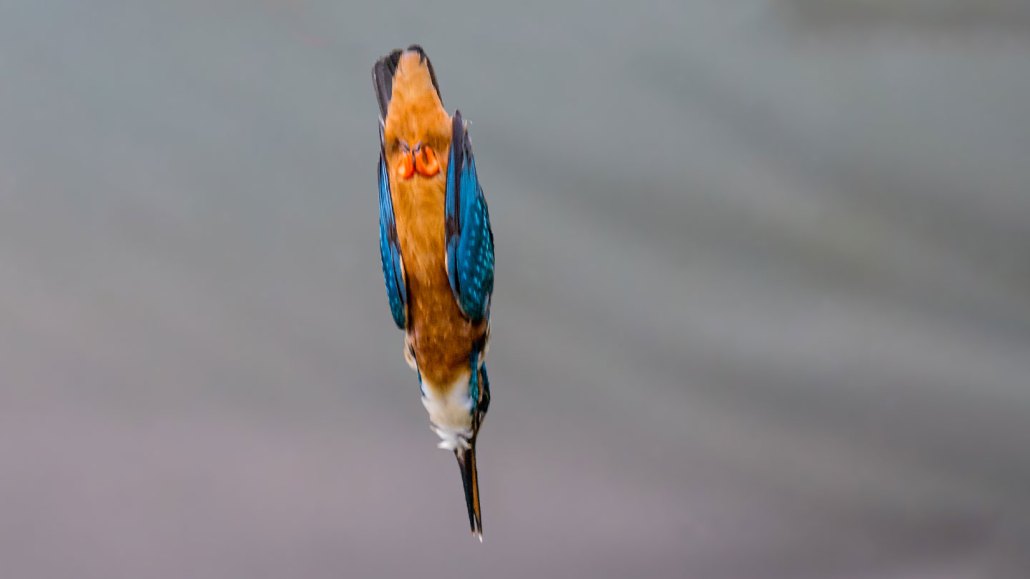
Flying at speeds up to 40 kilometers per hour as they hit the water, plunge diving kingfishers (one shown) are at risk of damaging their beaks, heads and brains.
Andy Morffew/Flickr (CC BY 2.0 DEED)
- More than 2 years ago
Read another version of this article at Science News Explores
Genetic tweaks in kingfishers might help cushion the blow when the diving birds plunge beak first into the water to catch fish.
Analysis of the genetic instruction book of some diving kingfishers identified changes in genes related to brain function as well as retina and blood vessel development, which might protect against damage during dives, researchers report October 24 in Communications Biology. The results suggest the different species of diving kingfishers may have adapted to survive their dives unscathed in some of the same ways, but it’s still unclear how the genetic changes protect the birds.
Hitting speeds of up to 40 kilometers per hour, kingfisher dives put huge amounts of potentially damaging pressure on the birds’ heads, beaks and brains. The birds dive repeatedly, smacking their heads into the water in ways that could cause concussions in humans, says Shannon Hackett, an evolutionary biologist and curator at the Field Museum in Chicago. “So there has to be something that protects them from the terrible consequences of repeatedly hitting their heads against a hard substrate.”
Hackett first became interested in how the birds protect their brains while she worked with her son’s hockey team and started worrying about the effect of repeated hits on the human brain. Around the same time, evolutionary biologist Chad Eliason joined the museum to study kingfishers and their plunge diving behavior.
In the new study, Hackett, Eliason and colleagues analyzed the complete genome of 30 kingfisher species, some that plunge dive and others that don’t, from specimens frozen and stored at the museum. The preserved birds came from all over the world; some of the diving species came from mainland areas and others from islands and had evolved to dive independently rather than from the same plunge-diving ancestor. The team wanted to know if the different diving species had evolved similar genetic changes to arrive at the same behaviors. Many kingfisher species have developed this behavior, but it was unclear whether this was through genetic convergence, similar to how many species of birds have lost their flight or how bats and dolphins independently developed echolocation (SN: 9/6/2013).
Previous studies had found convergence on beak shape, making plunging kingfishers’ long and pointy, which could allow them to dive more effectively into the water. “Do they all [adapt to plunge-diving] in the same way with their beaks, their brain … and with their genes?” Hackett wondered.
The analysis revealed evidence of 93 changed genes that seemed to signal genetic convergence. Of those, one stood out: It was a tweak in a gene that holds the instructions for making the tau protein, which, when functioning normally, helps to stabilize cells’ structure and could be a change to help the birds adapt to diving, the team suggests.
In humans, tau has been implicated in neurodegenerative diseases such as Alzheimer’s disease and shows up in clumps in brain tissue of people who have suffered multiple concussions. “It’s a very interesting hypothesis that the same [tau] protein has been reused to mitigate these hard impacts” in kingfishers, says Tim Sackton, a geneticist at Harvard University who was not involved with the study.
But, he says, the type of genetic analysis done in the study is tricky. Some of the convergent genes identified might be due to chance and not be related to the evolution of plunge diving behavior. More in-depth studies to identify which genetic changes are relevant to the diving behavior are warranted.
The next steps are to test what these genetic mutations and resulting proteins, particularly tau, do in kingfishers and how the genetic differences in diving species might protect them. If similar studies offer insight into how the birds protect their brains, the results could possibly be applied to developing protective strategies against concussions and brain injury for humans. But that’s in the distant future.
“We have a long way to go between understanding how the genotype and all of its modifications turn into what we see in the natural world,” Hackett says. “We’re just at the beginning of asking those questions.”






